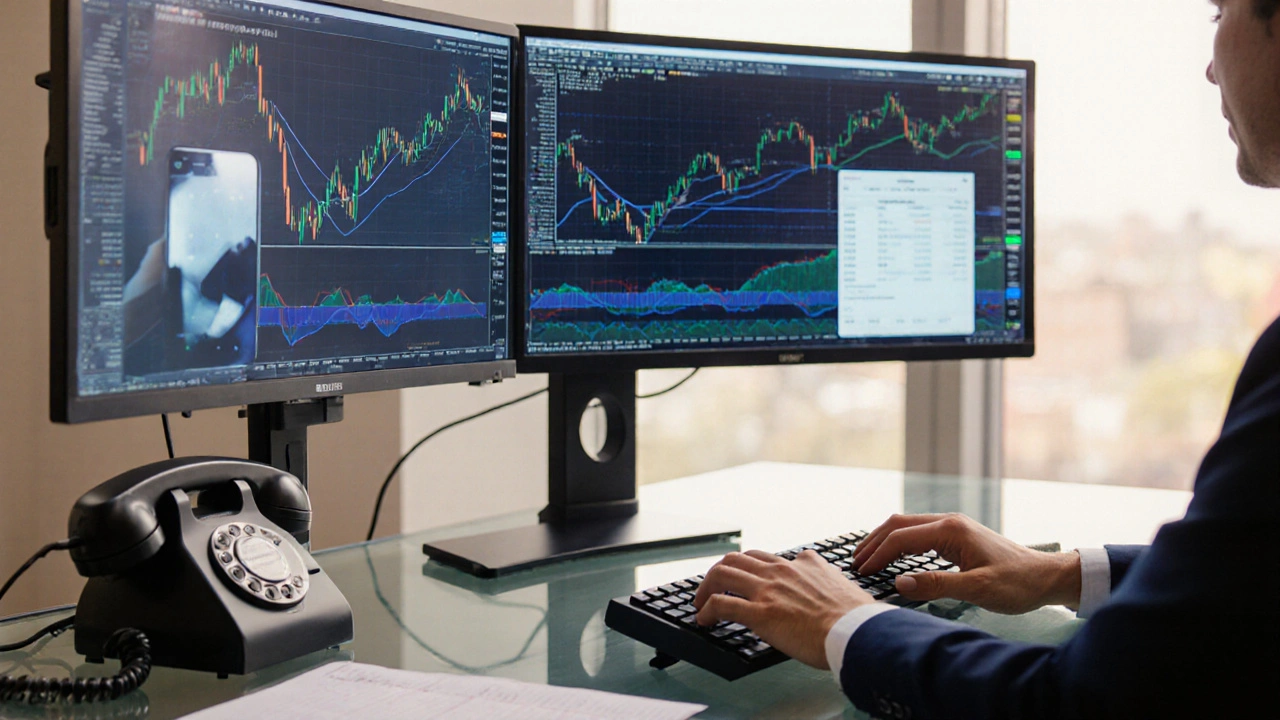Technology Impact on Trading Efficiency
Technology Impact Analysis Results
Performance Improvement:
Cost Reduction:
Speed Enhancement:
Accuracy Gain:
Accessibility:
Scalability:
Key Technologies in Modern Trading
Algorithmic Trading
Automates trades based on predefined rules, removing emotional bias and increasing speed.
Artificial Intelligence
Uses machine learning to analyze data and predict market movements with greater accuracy.
Mobile Apps
Enables trading anytime, anywhere with real-time access to markets and alerts.
Blockchain
Reduces settlement time and counterparty risk through decentralized record-keeping.
High-Frequency Trading
Executes trades in microseconds to capture small price differentials.
Cloud Computing
Provides scalable infrastructure for faster data processing and global access.
Every trader, from the weekend hobbyist to the full‑time professional, feels the pressure to stay ahead of the market. The secret sauce? Technology. From lightning‑fast order routing to AI‑driven signal generators, modern tools have reshaped how stocks are bought, sold, and managed. Below you’ll see why embracing the right tech can turn a mediocre portfolio into a competitive edge.
Key Takeaways
- Algorithmic and high‑frequency trading cut execution time to milliseconds.
- AI and data analytics turn raw market data into actionable insights.
- Mobile brokerage apps let you monitor and trade from anywhere, 24/7.
- Blockchain streamlines settlement, reducing counter‑party risk.
- Cloud‑based infrastructure provides scalability and lower latency.
Technology in stock trading is a collection of digital tools and platforms that automate, accelerate, or otherwise improve the process of buying and selling equities. Understanding its components helps you pick the right mix for your strategy.
Historically, traders relied on phone calls, manual entry, and paper confirmations. Those methods introduced delays, human error, and higher transaction costs. Today, a single trade can travel from a retail app to an exchange in under a tenth of a second, thanks to a suite of innovations that we’ll break down below.
Algorithmic trading is a method that uses pre‑programmed instructions to execute trades automatically. It eliminates the emotional bias that often trips up human traders and leverages speed that no person can match.
- Rule‑based engines trigger orders when price, volume, or technical indicators hit predefined thresholds.
- Back‑testing frameworks let you simulate strategies on historical data to gauge performance before risking real capital.
- Execution algorithms like VWAP (Volume‑Weighted Average Price) or TWAP (Time‑Weighted Average Price) slice large orders into smaller pieces, reducing market impact.
According to a 2024 study by the CFA Institute, firms that integrated algorithmic execution saw a 12% reduction in slippage on average. The key takeaway? Even a simple rule‑based bot can tighten spreads and protect profit margins.
Artificial intelligence (AI) brings machine learning models that can spot patterns humans miss.
AI engines ingest thousands of data points-price ticks, earnings reports, macro news, social sentiment-and output probability scores for market moves. Two popular applications are:
- Predictive analytics: Gradient‑boosted trees or deep‑learning networks forecast short‑term price direction with reported accuracies of 62% in high‑liquidity stocks.
- Natural‑language processing (NLP): Real‑time analysis of news headlines and earnings call transcripts can flag surprise events faster than conventional newswires.
Retail platforms such as TradeStation and Interactive Brokers now embed AI‑driven alerts into their dashboards, letting everyday traders benefit from sophisticated models without writing a single line of code.
Mobile brokerage apps have democratized market access.
With a smartphone, you can place a market order, set a stop‑loss, or monitor real‑time charts from a coffee shop. Key features driving adoption include:
- Zero‑commission trading: Most major brokers eliminated per‑trade fees in 2020, lowering the barrier for small‑scale investors.
- Instant deposits and withdrawals: Integration with services like Plaid speeds up fund movement, often within minutes.
- Push notifications: Real‑time alerts for price spikes, earnings releases, or margin calls keep you in the loop.
Data from a 2025 industry report shows that 68% of U.S. equity trades now originate on mobile devices, up from 45% in 2020. The trend underscores the need for a fast, reliable app if you want to stay competitive.

Blockchain technology is reshaping settlement and clearing.
Traditional settlement cycles (T+2 in the U.S.) leave room for counter‑party risk and operational delays. Blockchain‑based platforms promise near‑instant finality by recording trades on a decentralized ledger.
- Reduced settlement time: Projects like the DTCC’s Project i2i aim for T+0 settlement using distributed ledgers.
- Transparent audit trails: Every transaction is cryptographically sealed, simplifying compliance checks.
- Lower fees: By eliminating intermediaries, brokers can pass cost savings onto traders.
While mainstream adoption is still early, several ETFs now use blockchain for intra‑day NAV calculations, hinting at broader use cases on the horizon.
High‑frequency trading (HFT) represents the extreme end of algorithmic speed.
HFT firms co‑locate servers within exchange data centers, shaving microseconds off order latency. Benefits include:
- Ability to capture tiny price differentials that accumulate into significant profits.
- Provision of liquidity that tightens bid‑ask spreads for all market participants.
Regulators monitor HFT closely due to concerns over market stability, but for a trader building a micro‑strategy, understanding the mechanics can inform better order routing choices.
Cloud computing supplies the scalable infrastructure behind most modern trading platforms.
Instead of maintaining on‑premise servers, brokers now spin up virtual machines on providers like AWS, Azure, or Google Cloud. Cloud benefits include:
- On‑demand scaling: During volatile sessions, additional compute resources can be provisioned instantly to handle spike traffic.
- Geographic redundancy: Multiple data centers reduce the risk of outage affecting order flow.
- Cost efficiency: Pay‑as‑you‑go pricing aligns expenses with actual trading volume.
A 2023 survey of 120 brokerage firms found that 82% had migrated at least half of their trading engine workloads to the cloud, citing latency improvements of 15‑20% on average.
Comparison: Traditional vs. Tech‑Enhanced Trading
| Aspect | Traditional Approach | Tech‑Enhanced Approach |
|---|---|---|
| Order Execution Speed | Seconds to minutes (phone, manual entry) | Milliseconds to microseconds (algorithms, HFT) |
| Data Processing | Limited to end‑of‑day reports | Real‑time analytics, AI‑driven signals |
| Access Point | Brokerage desk or desktop terminal | Mobile app, web dashboard, API |
| Settlement Cycle | T+2 (two business days) | T+0 or near‑instant via blockchain |
| Cost Structure | Per‑trade commissions, higher spreads | Zero‑commission, lower spreads, subscription‑based AI tools |
Practical Tips for Integrating Technology into Your Trading Routine
- Start with a solid foundation: Choose a reputable broker that offers API access, low latency execution, and a robust mobile app.
- Automate the basics first: Use simple rule‑based bots for stop‑losses and take‑profit orders before diving into complex AI models.
- Leverage AI wisely: Begin with platform‑provided sentiment alerts rather than building custom models; evaluate performance quarterly.
- Test blockchain settlement pilots: If you trade large‑cap stocks, explore brokers that support instant settlement for faster cash availability.
- Monitor latency: Use ping tools to check distance to exchange data centers; consider a broker with co‑located servers if you need sub‑millisecond speed.
- Stay compliant: Keep logs of algorithmic decisions and ensure your bots respect market‑making rules to avoid regulator penalties.
By layering these steps, you can upgrade from a manual trader to a tech‑savvy participant without overwhelming your workflow.
Future Outlook: What’s Next for Trading Tech?
Looking ahead to 2026 and beyond, several trends are set to deepen the tech‑trading relationship:
- Quantum‑ready analytics: Early‑stage research suggests quantum computers could solve portfolio optimization problems in seconds.
- Decentralized finance (DeFi) integration: Hybrid platforms may let you trade traditional equities alongside tokenized assets on the same interface.
- Voice‑activated trading: Natural‑language processors will let you place orders via smart speakers, reducing friction even further.
While some of these innovations are still experimental, keeping an eye on them helps you anticipate the next wave of competitive advantage.

Frequently Asked Questions
What is the biggest advantage of algorithmic trading for a retail investor?
Algorithmic trading removes emotional bias and can execute orders at the optimal price within milliseconds, which is especially valuable during volatile sessions when manual entry would be too slow.
Can I use AI tools without programming experience?
Yes. Many broker platforms now bundle AI‑driven alerts and predictive scores directly into their dashboards, so you can benefit from machine learning without writing code.
Is blockchain really faster than traditional settlement?
Prototype systems have demonstrated near‑instant settlement (T+0) on public blockchains, but mainstream adoption is still limited. Expect incremental rollouts rather than a full switch overnight.
Do mobile trading apps compromise on security?
Modern apps employ biometric login, end‑to‑end encryption, and real‑time fraud monitoring. As long as you keep the app updated and use strong authentication, security is on par with desktop platforms.
How do I start integrating cloud services into my trading workflow?
Begin by selecting a cloud provider that offers low‑latency regions near your exchange (e.g., AWS us-east-1 for NYSE). Use managed database services for historical price storage and serverless functions to host lightweight bots. Most providers have free tiers to test the setup before committing.


